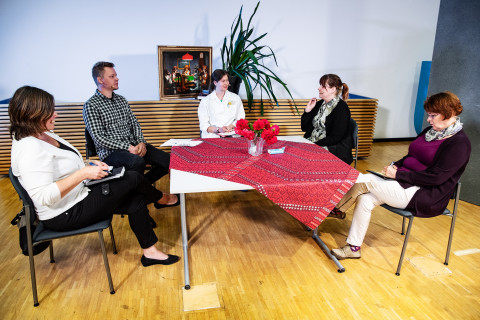Online simulations aimed at students and professionals dealing with family violence will soon be benefitting professionals in Namibia.
For years already, the University of Eastern Finland has been organising large-group simulations in collaboration between various disciplines and different professionals. These simulations have provided professionals with an opportunity to learn about interprofessional collaboration and interdisciplinary treatment of demanding, sensitive topics. Since 2020, simulations have been held online, and they have been aimed at students and professionals dealing with family violence.
Video for training professionals in Namibia
The Department of Social Sciences at the University of Finland has been collaborating with the University of Namibia by, for example, preparing joint educational materials on family violence. Now, the department has produced an English-language version of a family violence simulation, which is being expanded into an examination of the two cultures in the form of a video. The video, titled Early-Stage Intervention in Family Violence, has been tailored to Namibian needs and will be released in January 2024. Both Finnish and Namibian perspectives to addressing family violence are included, and Namibian students involved in anti-violence work in schools have also contributed to the video. In addition, University Lecturer, Dr Rachel Freeman of the University of Namibia tells in the video how professionals in Namibia deal with family violence.
“We find it important that these large-group simulations carried out at the University of Eastern Finland and involving different professionals find more targeted future uses in education. Perspectives from both cultures must also be included in educational materials used in an international context,” says Senior University Lecturer, Dr Kaarina Mönkkönen who, together with Senior University Lecturer, Dr Marja-Leena Hyvärinen, has been responsible for planning the content of this year’s online simulation.
“Family violence is equally prevalent in Finland and Namibia. In Finland, one in two women has experienced family violence, and in Namibia, one in three women aged 15–49 has experienced physical violence. In Namibia, alcohol consumption, poverty and unemployment are seen as the main reasons for this, but also the status of women plays a role. In Finland, reasons behind violence include heavy use of substances, personal crises, learned problem-solving behaviours and the need to control one’s partner,” Dr Mönkkönen says.
“Both universities have gained new insights and we have learnt a lot from each other. For example, our Namibian colleagues report having learned new things about interprofessional collaboration and about simulation as a teaching method. We, on the other hand, have learnt about how the victim’s entire community should be involved in the processing of the matter, and how family violence should not be dealt within the networks of authorities alone,” Dr Mönkkönen points out.
Perspectives from both cultures must be included.
Kaarina Mönkkönen
Senior University Lecturer
Master’s thesis explores interaction during a family violence simulation
This year’s online simulation was held on 10 October, and it was also attended by Jenni Jaakkola, whose Master’s thesis in the field of social psychology deals with interprofessional interaction during a simulation. In her study, she examined interaction between professionals as well as interaction between clients and professionals.
““I was interested in interaction as a whole, but also in the tiny details that may affect the process. In my study, I examined the means of multimodal interaction employed by professionals, and the dimensions, which professionals use to build successful interprofessional interaction and client interaction,” Jaakkola explains.
“Considering that a key objective of these simulations is to develop interprofessional interaction, it is also important to study and evaluate it,” Dr Mönkkönen says.
“It is often thought that interaction skills come in the same package as a vocational qualification. This, however, is not the case, and interaction skills must be deliberately practiced, and essential aspects of collaboration must be jointly identified,” Dr Hyvärinen notes.
Different studies show that when working with clients, successful interaction is a prerequisite for good support and care, and it also improves client engagement and satisfaction.
“The problems clients are dealing with are diverse, and the expertise of various professionals is needed. In order for interprofessional collaboration to succeed, interaction must be successful, too.”
In order for interprofessional collaboration to succeed, interaction must be successful, too.
Kaarina Mönkkönen
Senior University Lecturer


